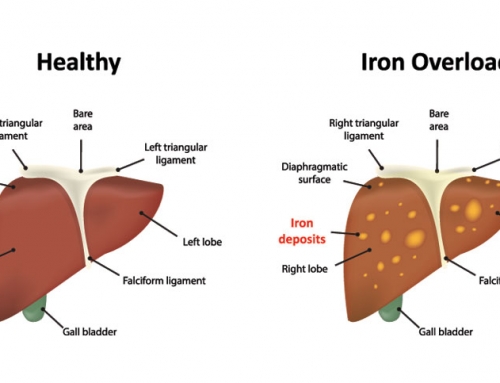How is Hemochromatosis diagnosed?
Hemochromatosis diagnosis is based on a combination of laboratory and genetic testing results. Genetic testing is used to confirm the diagnosis of hemochromatosis, and laboratory tests such as blood iron tests and liver biopsy can be useful in determining the progression of the disease and the types of treatment required.
GENETIC TESTING
Genetic testing of the HFE gene is used to confirm the diagnosis of hemochromatosis. The HFE gene encodes for the HFE protein expressed on the cell surface, which is responsible for regulating the absorption of dietary iron. HFE regulates iron uptake by interaction with the transferrin receptor, resulting in decreased binding affinity of transferrin to iron, which limits the amount of dietary iron uptake.
The HFE gene has three known mutations, C282Y, H63D and S65C, which are associated with increased chance of developing hemochromatosis. Of the three mutations, C282Y is most commonly found and carries the highest risk for iron overload when inherited in the homozygous state. The H63D and S65C mutations are less penetrant and have a lower chance of developing the disease when inherited in the homozygous state.
BLOOD IRON TESTS
Serum ferritin:
Ferritin is a protein that binds and stores iron in the body. The serum ferritin test measures the amount of ferritin in the blood, which reflects the amount of iron stored in the organs. People with hemochromatosis usually have high blood ferritin levels. However, elevated ferritin levels can also be caused by other factors, including liver disease, infection, cancer, heart disease, AIDS, metabolic disorders, and inflammatory conditions such as arthritis.
Serum iron:
The serum iron test measures the amount of iron in blood, which can be used to determine the amount of unbound iron in the body.
Total iron binding capacity:
Transferrin is a protein that transports iron in the blood from one part of the body to another. The total iron binding capacity test measures the total amount of iron that can be carried in the blood by transferrin and reflects how well the blood can transport iron.
Serum transferrin saturation:
Transferrin saturation is calculated by dividing serum iron by total iron binding capacity. The serum transferrin saturation test determines the percentage of transferrin being used to transport iron. A high transferrin saturation percentage (>45%) shows iron overload.
OTHER TESTS
Liver biopsy:
Previously, liver biopsy was widely used to diagnose hemochromatosis, but it is now rarely needed with the availability of DNA testing for hemochromatosis. During a liver biopsy, a small piece of tissue is removed from the liver using a thin needle. This procedure can determine the amount of iron stored in the liver and the extent of liver damage.
Liver enzymes test:
The liver enzymes test measures the function of the liver and is often used to check the progress of ongoing liver injury. It is typically used to determine if liver enzyme levels return back to normal with treatment for hemochromatosis.
Radiological imaging:
Imaging of the liver is often required using ultrasound, Computed Tomography (CT) scan or Magnetic Resonance Imaging (MRI). Structural imaging of the liver can be useful for visualizing liver damage and possible complications.
References:
Duchini A, Klachko DM, Sfeir HE (2014). Hemochromatosis.
Hemochromatosis.org. Provided by Iron Disorders Institute.
Hemochromatosis. National Heart, Lung, and Blood Institute. National Institutes of Health.
DNA In the News2017-04-06T19:21:21+00:00






